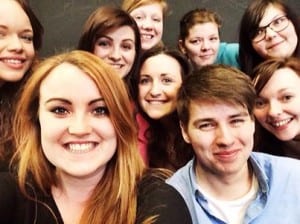My role:
I have really enjoyed fulfilling the role of the producer for No Added Sugar, especially during the last few weeks where our show has started to come together properly. Although I have taken on many jobs as producer (including budgeting, scheduling and setting deadlines), it has recently occurred to me that I don’t really know what the ‘official’ definition of a producer is…
My naivety about my actual job role seems ridiculous, however it seems I am not alone in my confusion about what a theatre producer actually does. It has been described as “one of the most mysterious jobs in the theatre”(Baggaley, 2008)- it is a role that is not firmly assigned definite tasks. Even James Seabright, a successful producer, writes in his book that “the producer’s role can appear confusing and indefinable” (Seabright, 2010, 5). Using his book, I have been piecing together all of the main components of the job and have checked my own progress against it. I feel reassured as it seems that I have indeed been doing the job properly- below is a list of the tasks I have been doing as producer and why they are essential for the smooth running of our theatre company.
The budget:
Seabright writes that a producer “makes sure a show is delivered on time and in budget” (Seabright, 2010, 5) and I have been responsible for No Added Sugar’s finance from the start of the project. My previous post goes into more detail about this aspect of my job role and it is something that I have enjoyed being in charge of. However, more recently I have felt the negative repercussions that come with being in control of the purse strings. As we spend more money and the budget becomes tighter, it has become vital for me to say no to certain costs. One example of this came out of today’s rehearsal as I had to decline the request to use a Polaroid camera on stage as the cost of the film was more than we expected and was not justifiable. Seabright also goes on to say that the producer “typically defines what is ‘on time’ and ‘in budget’” (Seabright, 2010, 5)- although we phycially had the money to spend on the film it would have been irresponsible to use it when we are still unaware about the full cost of our printing materials.
The rehearsal schedule:
I have been in charge of devising a schedule that firstly, suits everyone’s availability and secondly, provides the company with enough time to rehearse. The administrative side of the company is something that Seabright assigns to the producer which he describes as “oiling the wheels of a production for smooth running” (Seabright, 2010, 8).Myself and our wonderful stage manager Shellie have made this task as painless as possible through our system that involves me creating the actual schedule and then Shellie booking the rehearsal space. We list any known absences on the schedule and created them at least a month in advance to ensure that the majority of the company can be present.
The follow up:
Every week or so I post in our company’s Facebook group with a list of the tasks that need doing for the following week. As we are devising which can be a slow process, it is important that we set goals and deadlines that keep us on track. Here is an example of these kind of reminders presented to you in post-it form, just because I can!

Going forward:
I am now a lot more comfortable with my role knowing that every producer is different, and am confident in what I am doing. We are now just over a month away from the performance which means I must ensure that our deadlines are stuck to in order to have a completed and polished show by the 27th May. It is in these final weeks where my job becomes more important as we still have a lot of work to do. Despite all of this however, I am very excited and positive about our performance and am pleased with the progress we have made, especially that made in the last week.
Works cited
Baggaley, L. (2008) What’s the producer’s role? [online] London: the Guardian. Available from: http://www.theguardian.com/stage/theatreblog/2008/apr/04/whatstheproducersrole [Accessed 19 April 2014].
Seabright, J. (2010) So you want to be a theatre producer? London: Nich Hern Books.



